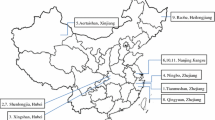Abstract
The Karyotype of seven species are described. Three of them are tetraploid (2n=32) and four triploid (2n=24). The chromosome numbers ofT. banhyhalense, T. tenebristylum, T. harbhajan-singhii ssp.pahalgamense, T. flavum andT. vulpinum f.pallidocarpum are recorded for the first time. Chromosomes are mostly medium to short in size. On the basis of chromosome morphology, in all sixteen chromosome types are recognised. None of these species shows multiple identical chromosome sets. The role of chromosome size and the number of chromosome pairs in multiple sets in evolution has been discussed.
Similar content being viewed by others
References
Babcock, E. B... “The genusCrepis. Part 1. The taxonomy, distribution and evolution ofCrepis,”Univ. Calif. Publ. Bot., 1947,21, 1–197.
Battaglia, E... “Ricerche sulla parameiosi restituzionale nel genereTaraxacum,”Caryologia, 1948,1, 1–47.
Chatterjee, T. and Sharma, A. K. “Cytotaxonomy of Cichorieae,”Genetica, 1969,40, 577–90.
Furnkranz, D... “Cytogenetische untersuchungen anTaraxacum in Raume Von Wien,”Ost. zot. Zeit., 1960,107, 310–50.
—————.. “Taraxacum apenninum,** ein altes Element mediterraner Gebirge,” Ibid., 1964,111, 231–39.
----- .. “Untersuchungen an populationen desTaraxacum officinale Komplexes in Kontaktgebiet der diploiden und polyploiden Biotypen,”Ibid.,113, 427–47.
Hou-Liu, S. Y... “Chromosome counts of someTaraxacum species,”Acta Bot. Neerl., 1963,12, 76–83.
Koul, M. L. H... “Chromosome numbers in some medicinal composites,”Proc. Indian Acad. Sci., 1964,59 B, 72–76.
—————.. “Floral biology, pollen morphology and cytogenetics ofTaraxacum officinale,”J. Sci. Res. Banaras Univ., 1966,17, 82–94.
Malecka, J... “Chromosome numbers of someTaraxacum species in Poland,”Acta Biol. Crac. Ser. Bot., 1958,1, 56.
—————.. “Cytological studies in the genus,Taraxacum,” 1962,5, 117–36.
—————.. “Chromosome numbers of 5Taraxacum species from Mongolia,” 1967,10, 73–83.
----- .. “Cytoembryological studies inTaraxacum scanicum,”Ibid., 1967,10.
Mehra, P. N., Gill, B. S., Mehta, J. K. and Sidhu, S. S. “Cytological investigations on the Indian Compositae. 1. North Indian Taxa,”Caryologia, 1965,18, 35–68.
Sharma, A. K. and Chatterjee, T. “Structural hybridity in a diploidTaraxacum,”Naturwiss,, 1961,4, 109–10.
Soest, J. L. Van.. “Taraxacum species from India, Pakistan and neighbouring countries,”Wentia, 1963,10, 1–91.
Sörensen, T... “Sexual chromosome aberrants in triploid apomicticTaraxaca,”Bot. Tidskr., 1958,1, 1–22.
—— and Gudjonsson, G. “Spontaneous chromosome aberrants in apomicticTaraxaca. Morphological and cytogenetical investigations K. Danske Videnskab. Selskab,”Biol. Skr., 1946,2, 1–48.
Stebbins, G. L., Jenkins, J. A. and Walters, M. S. “Chromosomes and phylogeny in the Compositae, tribe Cichorieae,”Univ. Calif. Publ. Bot., 1953,26, 401–30.
Author information
Authors and Affiliations
Additional information
Communicated by Prof. V. Puri,f.a.sc.
Rights and permissions
About this article
Cite this article
Singh, D., Kaul, V. & Dathan, A.S.R. Cytological studies in the genusTaraxacum weber. Proc. Indian Acad. Sci. 80, 82–91 (1974). https://doi.org/10.1007/BF03050662
Received:
Issue Date:
DOI: https://doi.org/10.1007/BF03050662




